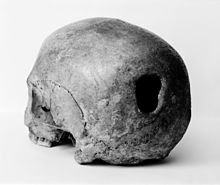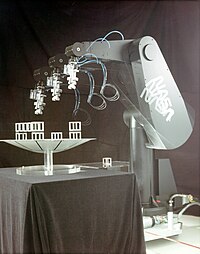User:Goliver21/sandbox
History
[edit]Neurosurgery, or the premeditated incision of ones head for pain relief, has been around for thousands of years. But, notable advancements in neurosurgery have only came within the last hundred years.

Ancient
[edit]Around 7000 years ago the beginning stages of neurosurgery were starting to develop. A procedure known as trepanation, or burrowing, was used to cure people of an "affliction", where cutting and removing sections of the skull would relive intracranial pressure.[1] The reasons to initiate such a procedure are up to debate and vary among the different cultures who practiced.[2] The procedure is still practiced today in parts of Africa, South America, and Melanesia. There is an international trepanning advocacy group (ITAG) website[3]
Modern
[edit]There was not much advancement in neurosurgery until late 19th early 20th century when electrodes were placed on the brain and superficial tumors were removed.
History of electrodes in the brain: In 1878 Richard Canton discovered that electrical signals transmitted on animals brain. In 1950 Dr. Jose Delgado invented the first electrode that was implanted in an animals brain. He was able to make an animal run and change direction. In 1972 the cochlear implant, a neurological prosthetic that allowed people to hear who were deaf, was marketed for commercial use. In 1998 researcher Philip Kennedy implanted the first Brain Computer Interface (BCI) into a human subject.[4]
History of tumor removal: In 1879 William Macewen is considered to have performed the first successful brain tumor removal.[5] In 1884 Dr. A. Hughes Bennett was considered to have completed the first primary brain tumor removal.[6] This is different for William Macewen in 1879 because Dr. Bennett operated on the exposed brain whereas Macewen operated outside of the "brain proper".[7] In 1907 Schioffer of Vienna was the first to remove a pituitary tumor.[8]
Modern Surgical Instruments
[edit]
The main advancements in neurosurgery came about as a result of highly crafted tools. Modern neurosurgical tools, or instruments, include chisels, curettes, dissectors, distractors, elevators, forcepts, hooks, impactors, probes, suction tubes, power tools, and robots.[9][10] Most of these modern tools, like chisels, elevators, forcepts, hooks, impactors, and probes, have been in medical practice for a relatively long time. The main difference of these tools, pre and post advancement in neurosurgery, were the precision in which they were crafted. These tools are crafted with edges that are within a millimeter of desired accuracy.[11] Other tools such as hand held power saws and robots have only recently been commonly used inside of a neurological operating room. Robotics have played an instrumental role in making neurosurgery safer, more precise, and less invasive. In 1985 Programmable Universal Machine for Assembly (PUMA) was the first robot to assist in neurological surgery. PUMA was able to guide incisions into the brain based off an x,y,z coordinate frame placed around the patients head. In 1991 Minerva was the first robot to provide real time imagery of the brain as it moved during the procedure. This allowed the surgeon to change their incision trajectory as the procedure progressed. In 1995 The Steady Hand System allowed surgeons to operate on patients and minimize slight tremors caused by the hand of the surgeon. [12]
Neuroanesthesia
[edit]
Neuroanestesia is a field of anesthesiology which focuses on neurosurgery. Anesthesia is not used during the middle of an "awake" brain surgery. Awake brain surgery is where the patient is conscious for the middle of the procedure and sedated for the beginning and end. This procedure is used when the tumor does not have clear boundaries and the surgeon wants to know if they are invading on critical regions of the brain which involve functions like talking, cognition, vision, and hearing. It will also be conducted for procedures which the surgeon is trying to combat epileptic seizures[13]
History
[edit]Early forms of neuroanestesia were found during procedures of trepanning in Southern America ,like Peru. In these procedures coca leaves and datura plants were used to manage pain as the person had dull primitive tools cut open their skull. In 400 BC The physician Hippocrates made accounts of using different wines to sedate patients while trepanning. In 60 AD Dioscorides, a physician, pharmacologist, and botanist, detailed how mandrake, henbane, opium, and alcohol were used to put patients to sleep during trepanning. In 972 AD two brother surgeons, in modern day India, used “samohine” to sedate a patient while removing a small tumor and awoke the patient by pouring onion and vinegar in the patients mouth. Since then, multiple cocktails have been derived in order to sedate a patient during a brain surgery. The most recent form of nueroanestesia is the combination of Carbon dioxide, hydrogen, and nitrogen. This was discovered in the 18th century by Sir Humphry Davy and brought into the operating room by Sir Astley Cooper[14]
Neuropathology
[edit]
Neuropathology is a specialty within the study of Pathology focused on the disease of the brain, spinal cord, and neural tissue.[15] This includes the central nervous system and the peripheral nervous system. Tissue analysis comes from either surgical biopsies or post mortem autopsies. Common tissue samples include muscle fibers and nervous tissue.[16] Common applications of neuropathology include studying samples of tissue in patients who have Parkinson's disease , Alzheimer's disease , Dementia, Huntington's disease, Amyotrophic Lateral Sclerosis, Mitochondria Disease, and any disorder that has neural deterioration in the brain or spinal cord.[17] [18]
History
[edit]Pathology has been studied ever since men have decided to cut each other open and see what is inside, thousands of years. But, only within the last few hundred years has medicine focused on a tissue and organ based approach to tissue disease. In 1810 Dr. Thomas Hodgkin started to look at the damaged tissue for the cause, not the gods. This was conjoined with the emergence of microscopy and started the current understanding of how we study the tissue of the human body.[19]
- ^ http://www.uic.edu/classes/osci/osci590/13_3%20Trephination%20An%20Ancient%20Surgery.htm
- ^ https://en.wikipedia.org/wiki/Trepanning
- ^ http://www.trepan.com/
- ^ http://biomed.brown.edu/Courses/BI108/BI108_2005_Groups/03/hist.htm
- ^ http://thejns.org/doi/pdf/10.3171/foc.2005.18.4.1
- ^ http://www.ncbi.nlm.nih.gov/pubmed/6387062
- ^ https://www.uakron.edu/gage/surgery.dot
- ^ http://www.neurosurgery.org/cybermuseum/microneurohall/jhardy.html
- ^ http://www.medicalexpo.com/medical-manufacturer/neurosurgery-surgical-power-tool-11882.html
- ^ http://www.stealthsurgical.com/department/neurosurgical-10000.cfm
- ^ http://news.psu.edu/story/285212/2013/08/26/impact/technology-increases-precision-safety-during-neurosurgery
- ^ http://biomed.brown.edu/Courses/BI108/BI108_2005_Groups/04/neurology.html
- ^ http://www.hopkinsmedicine.org/neurology_neurosurgery/centers_clinics/ionm/types/intraoperative-brain-mapping.html
- ^ http://thejns.org/doi/pdf/10.3171/2014.2.FOCUS13578
- ^ http://www.mc.vanderbilt.edu/root/vumc.php?site=vmcpathology&doc=12892
- ^ http://neuropathology.stanford.edu/
- ^ http://neuropathology-web.org/chapter9/chapter9aDementia.html
- ^ http://www.ncbi.nlm.nih.gov/pubmed/17541738
- ^ http://www.ncbi.nlm.nih.gov/pmc/articles/PMC2895866/

